Aokigahara - suicide forest. Aokigahara is the last refuge of ghosts and suicides.
Aokigahara Forest is known as Jukai (meaning “sea of trees” in Japanese) and is located at the foot of (Honshu Island) in Japan. It is not included in any excursion program to the sights of the country, but many tourists come here when they come to Mount Fuji. Many of them do not even realize that they are in the most sinister and mysterious point in Japan.
The history of the forest
The most powerful eruption of Mount Fuji occurred in 864. A huge stream of fiery lava descended along the northwestern slope. A lava plateau was formed, the area of which reached 40 square kilometers. A forest gradually appeared in this place.
Its soil looks as if someone tried to uproot centuries-old trees. Their roots, which are not able to break through the lava rock, come out, intricately intertwined over fragments of rocks that in ancient times were thrown out of the crater of the volcano.
Japan, Aokigahara forest: description
The relief of this amazing forest area is covered with numerous caves and crevices, some of them stretch hundreds of meters underground, and in most of them the ice does not melt even in the summer heat. The total area of the massif is just over 35 square kilometers.
The peculiarities of its location (lowland, dense forest) provide these places with a ringing, deafening silence. Experts believe that there are rich reserves in the underground depths of the forest area. iron ore. This probably explains the fact that compasses do not work in the forest.
The land on which this strange forest is located cannot be cultivated with hand tools (a hoe or a shovel). The Japanese Aokigahara forest is considered young, as it appeared approximately 1,200 years ago. Mount Fuji last erupted in 1707. For some unknown reason, the lava did not cover one of the slopes, whose area is about 3,000 hectares. Later it was overgrown with a dense forest consisting of pines, boxwood and other conifers.
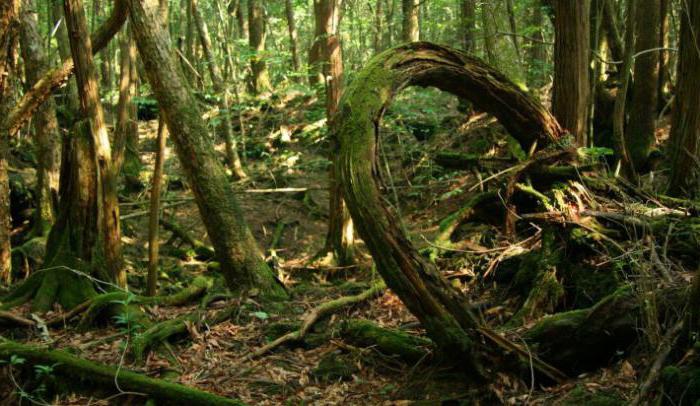
Aokigahara Forest (Jukai) - national park, along which several tourist routes are laid. They offer a climb up the northern slope of Mount Fuji and walks through a beautiful forest area. Since Aokigahara Forest is located near the capital of the country (Tokyo), there are many ways to enjoy nature in nature. Its attractions include the wind and ice caves.
This forest, according to many Japanese, is a sad landmark of the country. It is often called nothing more than the forest of suicides. Aokigahara was originally associated with Japanese mythology and was traditionally considered a place where ghosts and demons lived.
Tales and legends
Legends about this mysterious place have been known to the inhabitants of Japan since the Middle Ages. They say that in the 19th century, poor families were brought to the forest and left there, dooming their parents and children, whom they were unable to feed, to certain death. The groans of the unfortunate did not penetrate the wall of powerful trees, and no one heard the groans of those doomed to a terrible, painful and long death. Local residents are sure that their ghosts are still waiting for lonely travelers in the forest, seeking revenge for the suffering that befell them.
Today there is no famine in Japan, but the Aokigahara forest plays an ominous role even today. The ringing silence and mystical landscape of this place attract here, like a magnet, those who have decided to voluntarily commit suicide. Even more chilling are the legends about the numerous ghosts that hide in this forest.
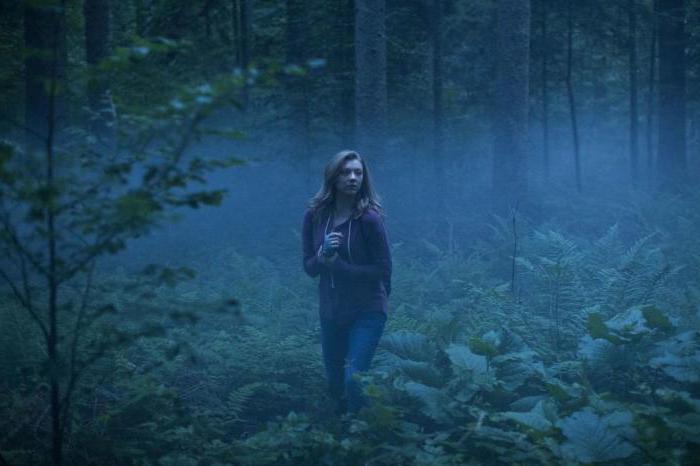
Children in Japan pronounce the word “Aokigahara” in a whisper when they begin to tell each other horror stories in the evening twilight. All tourists are reminded to be careful. Under no circumstances should you deviate from the paths and go deep into the forest. It’s easy to get lost in this vast sea of trees. If you move a few tens of meters away from the path, that’s all, you can get lost for a long time, if not forever... In this situation, even a compass will not help - it randomly rotates the arrow, making this device completely useless.
Suicide Forest (Aokigahara)
This name is firmly attached to this array. The Aokigahara forest, the photo of which you see in this article, for unknown reasons, is very attractive to people who decide to leave this world. According to this indicator, it ranks second in the world, second only to that located in San Francisco.
Every year, between 70 and 100 bodies are discovered in the forest. Since 1970, the Japanese police began to officially search for the bodies of suicides. The country's statistics provide a frightening fact - the number of bodies found in the forest is increasing from year to year. The most common methods of suicide are drug poisoning and hanging.
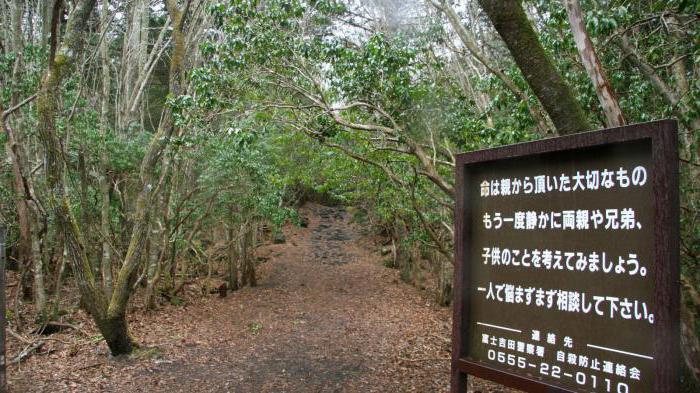
Eyewitnesses claim that it is enough to walk just a few meters deep into the forest and you can find various things on the ground - plastic bottles, bags, packaging of medicines.
Aokigahara Thickets
In Japan, constant work is underway to search, evacuate and bury discovered bodies. This responsibility was assigned to the authorities of the three localities closest to the forest (Fujikawaguchiko, Kamikuishiki and Naruchawa).
For this purpose they are allocated annually cash from the country's budget of 5 million yen every year. The special rooms set aside for this are overflowing with bodies that are not wanted by anyone.
At the entrance to the forest, you can see a poster calling on people, tired of countless problems and worries, to look at their lives as a priceless gift from their parents. They are asked to think about their family and loved ones. People for whom life is not a joy are convinced that they are not alone in their misfortune. There will be those who can help them solve the most difficult problems. Below is a phone number they can call.
Prevention measures
In order to prevent new attempts on their own lives, local authorities are taking various measures - installing signs with appeals, video cameras along the road and on paths leading into the forest. In local stores you cannot buy strong drugs or ropes, which are most often used to commit suicide.
It must be said that employees of stores located along the roads leading to the forest have learned to accurately identify from a crowd of people those who are contemplating suicide. According to their observations, these people, before walking along the path, walk nearby for some time, while trying not to make eye contact with anyone.
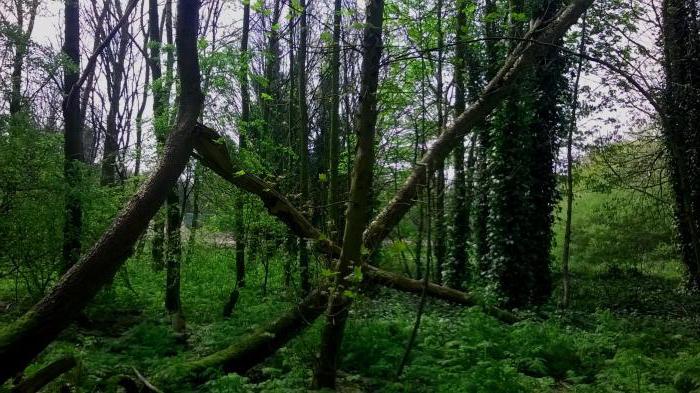
By agreement with the police, at the slightest suspicion, all employees are required to report them. Regular patrolling of surrounding roads and forests by volunteers and police helps prevent suicides. Aokigahara Forest (Japan) is often visited by men who are especially striking. Having not given up the habit of constantly wearing a formal suit, they wander through the forest paths in office clothes. The police detain such “tourists” first.
Once a year, the Aokigahara forest undergoes a thorough inspection. The police and a large group of volunteers (at least 300 people) take part in it. The forest areas they inspect are fenced off with tape.
This is how it is, mysterious and ominous, deafening with its incredible silence, but at the same time beautiful in its pristine state - Aokigahara Forest.
This place, of course, is not on the list of tourist attractions, but many tourists visit it during a trip to the famous Mount Fuji, without even realizing that they are in the most ominous point in Japan.
Aokigahara Jukai Forest, located at the foot of the volcano, is the complete opposite of the beauty and majestic tranquility of the main peak of the country. Aokigahara translates to “plain of green trees.” Its second name Jukai - “Sea of Trees”, is fully justified, since from a height this massif of dense green mass really resembles a rippling sea.
In 864 there was a powerful eruption of Mount Fuji. A powerful lava flow descending along the northwestern slope formed a huge lava plateau with an area of 40 square meters. km, on which it began to grow very unusual forest. The soil is dug up, as if someone was trying to uproot centuries-old trunks.
The roots of the trees, unable to break through the solid lava rock, come up, intricately intertwined over rocky fragments that were once thrown out of the crater of the volcano. The relief of the forest is furrowed with crevices and numerous caves, some of which extend underground for several hundred meters, and in some of them the ice does not melt even in the summer heat.
The Aokigahara area is one of Tokyo's favorite weekend destinations. There are walking paths through the forest, picnics are held on the vast lawns, children play ball or fly kites, and tourist brochures serenely tell about birds, foxes and flowers. The incomparable views of Fuji attract numerous photographers and artists.
However, this place is famous not only for its outdoor walks. Japanese children pronounce the word “Aokigahara” in a whisper when it’s time for scary stories with the onset of darkness. Tourists are reminded to be careful and under no circumstances stray from the paths deep into the forest.
In this sea of trees, it’s really not surprising to get lost: you move a few tens of meters away from the path and that’s it, you can get lost for a long time, if not forever... Even a compass will not help you get out of the dense thickets: a magnetic anomaly causes the needle to spin randomly, making this device completely useless.
But most of all, the legends about numerous ghosts hiding in the forest excite the blood. This place became notorious back in the Middle Ages, when in years of famine, desperate poor people brought their elderly and infirm relatives to the forest and left them there to die.

The groans of these unfortunates could not break through the dense wall of trees, and no one heard the groans of those doomed to a painful death. The Japanese say that their ghosts lie in wait for lonely travelers in the forest, wanting to take revenge for their suffering.
Nowadays, no one suffers from hunger in Japan, but Aokigahara continues to play its ominous role even now. The mystical landscape and ringing silence of the legendary forest attracts those who decide to voluntarily take their own lives. In terms of the number of suicides committed annually, Aokigahara is second only to the Golden Bridge in San Francisco. Since 1970, the police officially began searching for the bodies of the dead, for which special funds in the amount of 5 million yen are allocated from the treasury annually.
Once a year, the police, together with a large group of volunteers (about 300 people), comb the forest. It is reported that between 30 and 80 bodies are found during such raids. This means that, on average, every week someone enters this “sea of trees”, never to return... Three nearby villages, which are responsible for collecting this terrible harvest, have facilities for storing unidentified remains.
Official authorities are trying to stop this flow of suicides. The owners of local shops are voluntary assistants to the police: they track suspicious people, having learned to accurately identify from the crowd of tourists those who have come here to commit suicide.
Typically men in formal office attire, one store employee said, “they hang around for a while before heading down the path, and they try not to make eye contact with anyone.” Such cases are immediately reported to the police.

There are rumors about the Aokigahara forest that between the trees you can see here and there the white ghostly outlines of yurei. According to Shintoism, the souls of those who die a natural death are united with the spirits of their ancestors. Those who die violently or commit suicide become wandering ghosts - .
Finding no peace, they come to our world in the form of legless ghostly female figures with long arms and eyes glowing in the dark. And the ringing silence of the forest is broken at night by their groans and heavy breathing.
Why do the Japanese, who seem to live in such a prosperous country, take one of the first places in the world in the number of suicides? More often than other reasons, job loss is called.
Many people say that the Japanese have become too pragmatic, and the lack of money means too much in modern world. But here, perhaps, an important role is played by the mentality that developed many centuries ago, when the loss of social status is perceived as the worst of evils and can push one to commit suicide.
Also, from ancient times, another terrible ritual has survived to this day, called “suicide by conspiracy” in Japan. This refers to the voluntary departure from life of two lovers who, for some reason, cannot be together in this world. The belief that simultaneous death will unite them in other world, is still very strong.
"Suicide by conspiracy" is still so common in Japan that when the bodies of a man and a woman are found side by side, the police usually do not investigate thoroughly, considering the case obvious. One of these cases is described in the detective novel by Seite Matsumoto, published in Russia under the title “Points and Lines.” Although this novel is not about Aokigahara, it does deal with the topic at hand.
A surge in suicide pilgrimages to the Aokigahara forest was caused by the work of the writer Wataru Tsurumi “ Complete Guide on suicide,” published in 1993 and immediately became a bestseller: more than 1.2 million copies were sold in Japan.
This book provides detailed description various ways suicides, and the author described Aokigahara as “a wonderful place to die.” Copies of Tsurumi's book were found near the bodies of some of Aokigahara's suicides...
Hello dear readers!
Today I want to tell you about a place that is rightfully one of the most terrible on our planet. Today we'll talk about Aokigahara (Jukai). This is a forest located at the foot of Mount Fuji in Japan. There are many legends about it about ghosts and evil spirits, and about 100 people commit suicide there every year. So, let’s plunge headlong into the dense cover of Jukai.
Aokigahara resembles a real forest from a gothic fairy tale. The dense crowns, merging together into a green sea, do not let in not only light, but also sound. The roots of the trees spread out in all directions, huge and gnarled. Entering the forest, you can immediately notice that you are enveloped in an unnatural silence that presses on your ears. Your own breathing will seem terribly loud to you. It is also worth noting that the air in the forest is very stale, and the temperature inside it is much lower than outside it. This situation has a significant impact on the psyche. You immediately get the eerie impression that someone is watching you.

Because the forest landscape is very monotonous. It couldn't be easier to get lost in a place like this. Therefore, tourists who come in search of thrills are strongly advised not to deviate from the path. After all, only a miracle can help a lost traveler, since in Aokigahara you cannot rely on a compass, GPS, or any electronic devices because under the forest there are rich deposits of iron ore, creating a strong magnetic anomaly. The most reliable way is to take sticky tape with you in order to use it to make marks on trees along the way.
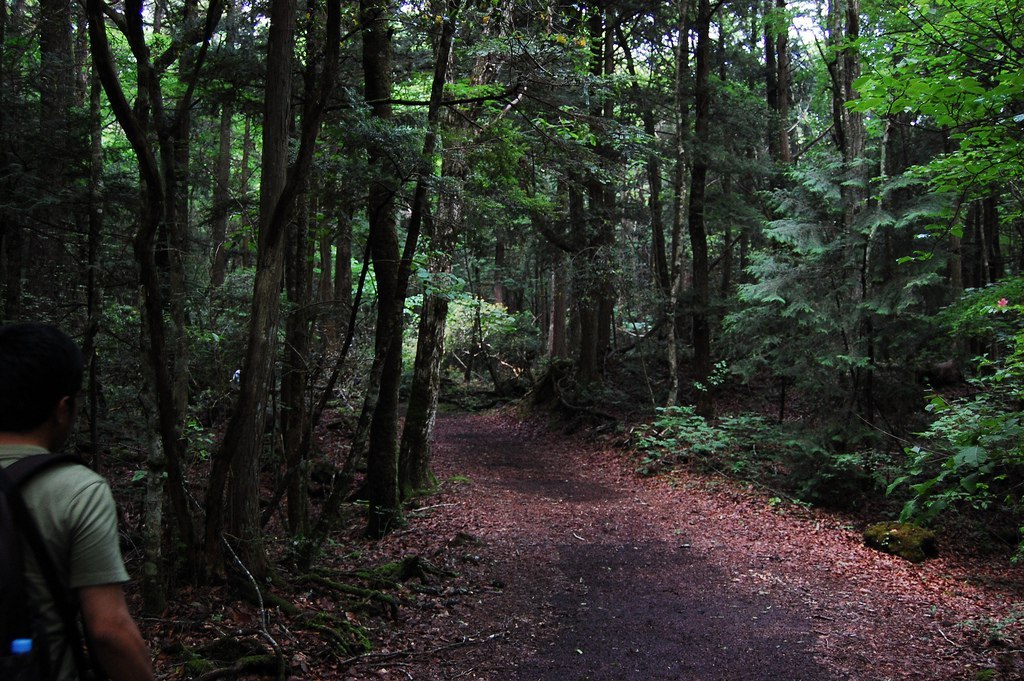
It is believed that Jukai is home to many ghosts. The Japanese call them yurei. Yurei look like phosphorescent figures with long thin hands, but without legs, and their eyes glow with ruby fire. They wander aimlessly among the trees, emitting heavy sighs and groans. According to legends, after death, a person’s soul leaves the body and intertwines with the souls of relatives, but if the death was violent and the soul was poisoned by a thirst for revenge or the burial ritual was violated, then it becomes a yurei.
Legends about ghosts are not without foundation. In medieval Japan, the custom of ubasute was practiced, when poor families during famine took old people and children whom they could not feed into the forest and left them there to die. Until their last breath, the unfortunate people cursed those who abandoned them in the middle of the forest alone to certain death, and their souls, possessed by malice, became eternal prisoners of Aokigahara.

But Jukai is known to the whole world not because of its terrible ancient customs. It has the reputation of a place where suicides constantly occur; in terms of their number, it is surpassed only by the Golden Gate Bridge in San Francisco. The nickname the Forest of Suicides, which was given to it in the world, is well deserved, because on average, from 70 to 100 bodies of people who committed suicide are found there every year.

A series of suicides began in the 50s of the 20th century and became a real problem for the Japanese authorities. They are trying in vain to fight this problem, for example, on the territory of Aokigahara there are signs urging people to come to their senses and not commit suicide; below is the helpline number. Video cameras are installed on some paths. Local residents and shop owners are well instructed on how to spot a potential suicide. You cannot buy rope or certain medications nearby that can help you take your own life. The population of three villages: Narusawa, Ashivada, Kamikuishiki has learned to easily identify those who come to the forest not for a walk. Seeing a suspicious person, residents immediately call the police. According to them, it is quite easy to spot a suicide. He has a lost, detached look and wanders aimlessly for a long time before entering the forest. He often wears a formal office suit, not at all typical for a walk in the park.
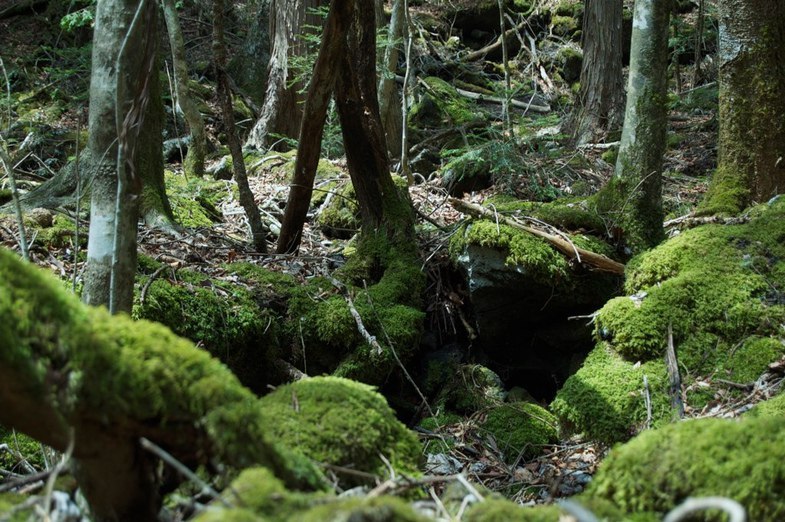
Aokigahara, also called Jukai, is a forest at the foot of the sacred Mount Fuji, on Japanese island Khonshu, who has gained a very bad reputation. This forest is a sad landmark of Japan and it became famous for becoming the most popular place among Tokyo residents who want to say goodbye to life. Every year, in the depths of this forest, from 70 to 100 people who committed suicide are found. People with unstable mental health should refrain from viewing this article.
Translated from Japanese, Aokigahara means “plain of green trees”, and Jukai means “sea of trees”. And in truth, if you look at the forest from above, you get the impression that there is a green sea in front of you.
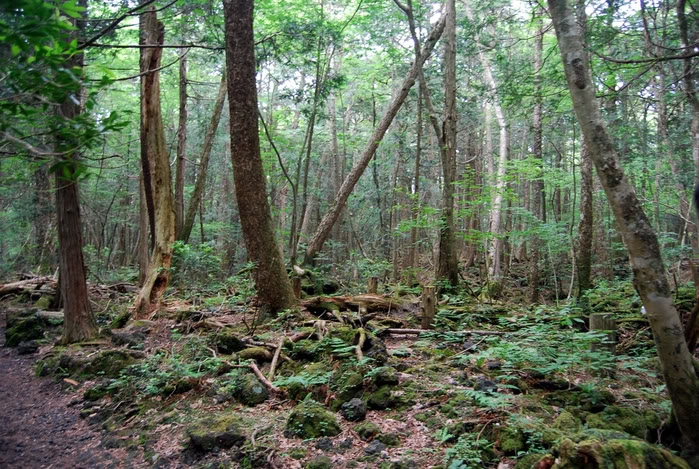
This forest was formed in 1707, after a powerful eruption of Mount Fuji, the lava of which, for unknown reasons, did not cover a vast area of land with an area of about 3,000 hectares, on which an unusual forest began to grow.

The entire forest area consists of bizarrely shaped trees, as if uprooted by a huge giant. Also, in the thicket of the forest there are many caves and crevices, adding an even more frightening look to the already eerie forest.

Aokigahara is considered a national park with several hiking trails, but you need to be a real daredevil to go on a voluntary journey through this forest. Although this place is a favorite for photographers and artists who are inspired by the picturesque nature of the forest.

However, this forest is notorious among the people of Japan. The Japanese themselves call this place the Suicide Forest.

Initially, Aokigahara was considered the habitat of demons and ghosts, terrible legends about which place have been known to the Japanese since the Middle Ages. It is also known that in the 19th century, poor families who could not feed their elderly and children brought them and left them in this forest to certain death. Since then, superstitious Japanese believe that the forest is full of spirits and ghosts that live in the thicket of Aokigahara.

Although nowadays no one leaves their relatives in this forest, the ominous place still takes revenge on the inhabitants of Japan. For some unknown reason, this place, like a magnet, attracts people who decide to commit suicide. Aokigahara is the second most popular place to commit suicide, behind the Golden Bridge in San Francisco.
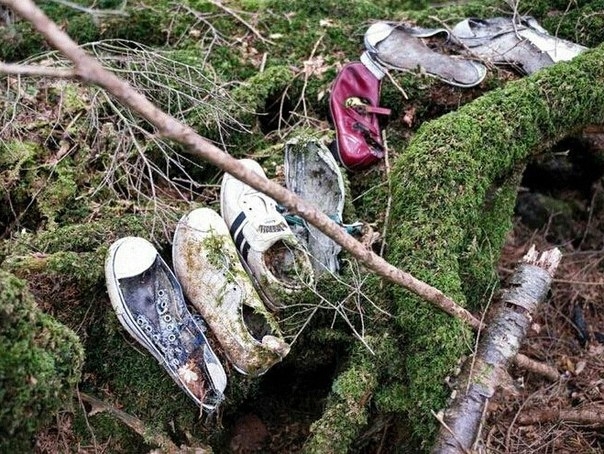
Since 1970, the police began official searches for the bodies of suicides, and every year the number of victims found in this forest only increases.
![]()
The most popular methods of death among suicides are hanging and drug poisoning.
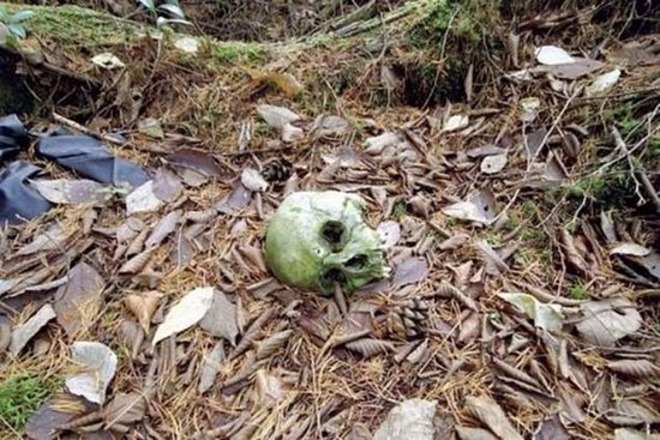
According to eyewitness accounts, it is enough to take just a couple of dozen steps into the thicket of the forest, and you can see things on the ground, empty pill bottles, bags and even ropes hanging from trees.

As one of the methods to combat suicide, the Japanese authorities have installed signs at the entrance to the forest with a helpline number, and the sale of medicines and ropes is prohibited in local stores.

Once a year, volunteers and police inspect the area around the forest for new bodies. Tourist guides urge those wishing to walk through this forest not to deviate from the official routes, since it is very easy to get lost in the forest.
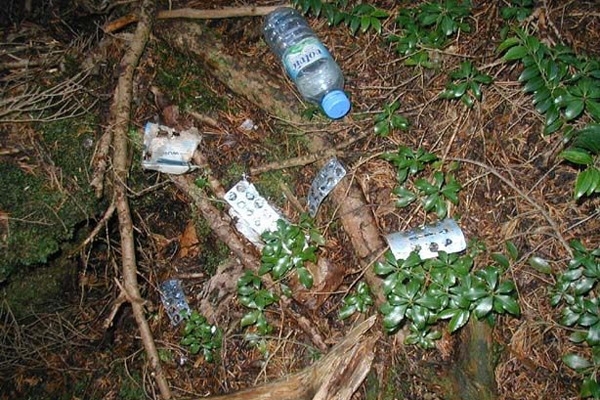
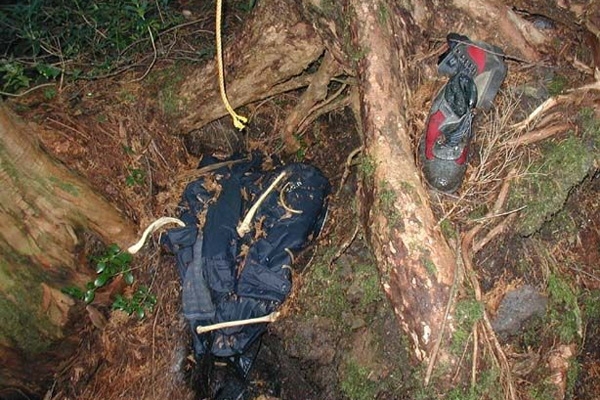
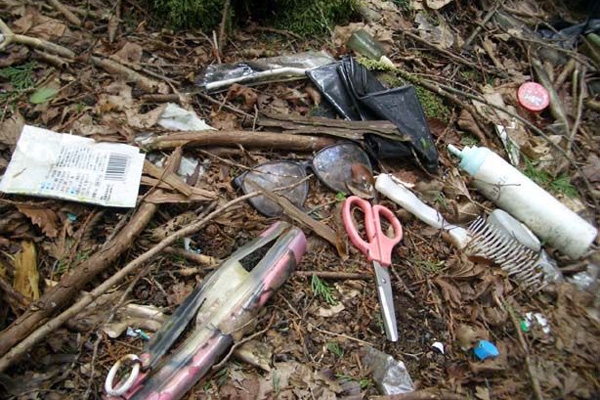
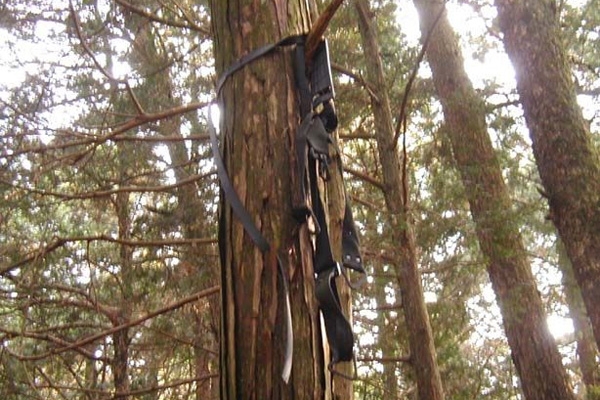
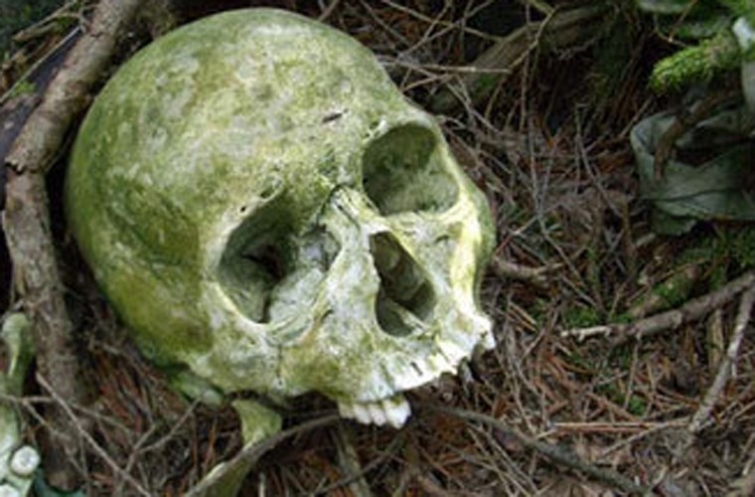


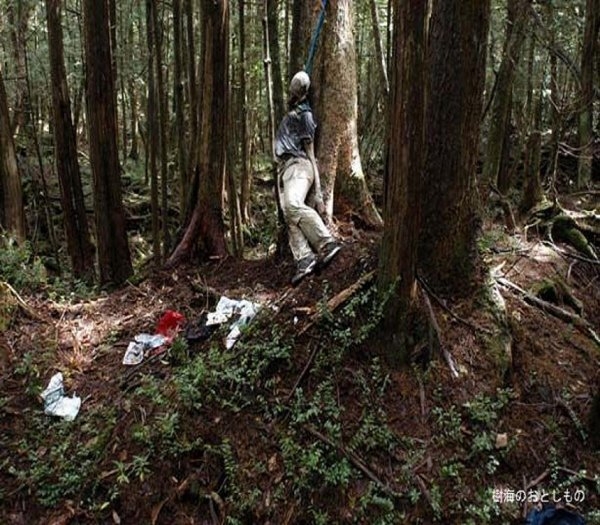



But it turns out that’s not all.
Aokigahara (青木ヶ原?, “Plain of Green Trees”); also known as Jukai (樹海?, "Sea of Trees") is a forest at the foot of Mount Fuji on the Japanese island of Honshu. The forest, located right at the foot of the volcano itself, is the complete opposite of the beauty and majestic tranquility of these places.
The total area is approximately 35 sq. m. km. The terrain of the forest includes many rocky caves, and the features of the location, in particular the density of the forest and the lowland, provide a “deafening” silence. It is also stated that there are vast deposits of iron ore underground in the forest area, which seems to explain the fact that compasses do not function in Aokigahara. The land on which the forest is located is volcanic rock that is quite dense and cannot be worked with hand tools such as hoes and shovels.
Aokigahara is considered a young forest because it was formed approximately 1,200 years ago. The last major eruption of Mount Fuji occurred in 1707 and for some reason did not cover one of the slopes with lava, covering an area of about 3,000 hectares of land. Later, this area was overgrown with a dense forest of boxwood, pines and other conifers. The trees stand almost like a solid wall.
But that’s not what’s terrible here...
The soil is dug up, as if someone was trying to uproot centuries-old trunks. The roots of the trees, unable to break through the solid lava rock, come up, intricately intertwined over rocky fragments that were once thrown out of the crater of the volcano. The relief of the forest is riddled with fractures and numerous caves, some of which extend underground for several hundred meters, and in some of them the ice never melts.
Aokigahara's fauna includes wild foxes, snakes and dogs.
Aokigahara is a national park with several tourist routes offering a climb to Mount Fuji along the northern slope, as well as walks through the beautiful forest. Because the forest is close to Tokyo and offers many different ways to spend time outdoors, Aokigahara is a popular destination for picnics and weekend walks.
Among the park's attractions are the Ice Cave (氷穴 hyoketsu?) and the Wind Cave (風穴 fuketsu / kazeana?).
In 864 there was a powerful eruption of Mount Fuji. An indestructible lava flow descending along the northwestern slope formed a huge lava plateau with an area of 40 square meters. km, where a very unusual forest took root. The soil is dug up, as if someone was trying to uproot centuries-old trunks. The roots of the trees, unable to break through the solid lava rock, come up, intricately intertwined over rocky fragments that were once thrown out of the crater of the volcano. The relief of the forest is riddled with fractures and numerous caves, some of which extend underground for several hundred meters, and in some of them the ice never melts.
As dusk sets in, people begin to talk about this place only in whispers. Disappearances and frequent suicides - this is the real face of Aokigahara. Tourists are strictly warned not to turn off the main paths into the depths of the forest because it is easy to get lost here. The magnetic anomaly makes the compass completely useless, and the similar terrain makes it impossible to find the exit from memory. Legends have long been written about the numerous ghosts that live in the forest. This place became notorious back in the Middle Ages, when in years of famine, desperate poor people brought their elderly and infirm relatives to the forest and left them there to die. The groans of these unfortunates could not break through the dense wall of trees, and no one heard the groans of those doomed to a painful death. The Japanese say that their ghosts lie in wait for lonely travelers in the forest, wanting to take revenge for their suffering.
There are rumors that here among the trees you can see the white ghostly outlines of yurei. According to Shintoism, the souls of those who die a natural death are united with the spirits of their ancestors. Those who suffered a violent death or committed suicide become wandering ghosts - yurei. Finding no peace, they come into our world in the form of legless ghostly figures with long arms and eyes glowing in the dark. And the oppressive deathly silence of the forest is broken at night by their groans and heavy breathing. Those who decide to visit Aokigahara must have strong nerves. It happens that a branch crunching under your feet turns out to be a human bone, and the strange outline of a person in the distance is the corpse of another hanged man.
Only two types of people voluntarily go deep into the “forest of death” - members of special teams of police and firefighters who comb Aokigahara every autumn in search of the remains of suicides, and even the suicides themselves.
Nowadays, no one suffers from hunger in Japan, but Aokigahara continues to play its ominous role even now. The mystical landscape and ringing silence of the legendary forest attracts those who decide to voluntarily take their own lives. In terms of the number of suicides committed annually, Aokigahara is second only to the Golden Bridge in San Francisco. Since 1970, the police officially began searching for the bodies of the dead, for which special funds in the amount of 5 million yen are allocated from the treasury annually. Once a year, the police, together with a large group of volunteers (about 300 people), comb the forest. It is reported that between 30 and 80 bodies are found during such raids. This means that, on average, every week someone enters this “sea of trees”, never to return... Three nearby villages, which are responsible for collecting this terrible harvest, have facilities for storing unidentified remains.
A surge in suicide pilgrimages to the Aokigahara forest was caused by the work of the writer Wataru Tsurumi, “The Complete Guide to Suicide,” which was published in 1993 and immediately became a bestseller: more than 1.2 million copies were sold in Japan. This book provides detailed descriptions of various methods of suicide, and the author described Aokigahara as “a wonderful place to die.” Copies of Tsurumi's book were found near the bodies of some of Aokigahara's suicides. Local authorities worried about a never-ending wave of suicides
There are posters along the forest paths with the following content:
Your life is a priceless gift from your parents.
Think about them and your family.
You don't have to suffer alone.
Call us
22-0110
Local shops do not sell any means (tablets, ropes) that could be used to commit suicide. There are special patrols in the surrounding areas that catch those wishing to get to Jukai as they approach. It is easy to identify those who decide to go to the forest: most often they are men in business suits.
It is impossible to say for sure how much these words reduce the number of victims, but every year dozens of new bodies are found in the forest. Of course, not everyone is found: there are also those who take their own lives in a completely uninhabited wilderness. There the remains of the weak in spirit are taken away beasts of prey making them part of this forest forever.
In 1960, a book by the writer Seicho Matsumoto, “Wave Pagoda” (Japanese: 波の塔 Nami no to), was published in Japan, which told about a woman who once committed suicide in Aokigahara. Later, based on this novella, a television series was produced, which gained extraordinary popularity in Japan.
Why do the Japanese, who seem to live in such a prosperous country, take one of the first places in the world in the number of suicides? More often than other reasons, job loss is called. Many people say that the Japanese have become too pragmatic, and the lack of money means too much in the modern world. But here, perhaps, an important role is played by the mentality that developed many centuries ago, when the loss of social status is perceived as the worst of evils and can push one to commit suicide.
Also, from ancient times, another terrible ritual has survived to this day, called “suicide by conspiracy” in Japan. This refers to the voluntary departure from life of two lovers who, for some reason, cannot be together in this world. The belief that simultaneous death will unite them in the other world is still very strong. "Suicide by conspiracy" is still so common in Japan that when the bodies of a man and a woman are found side by side, the police usually do not investigate thoroughly, considering the case obvious. One such case is described in a detective novel by the same author, Seicho Matsumoto, published in
Released in 2005 documentary“The Sea of Trees” (樹の海 Ki no Umi?), in which director Tomoyuki Takimoto tells the story of four people who decide to kill themselves in Aokigahara. At the 17th Tokyo International Film Festival, the film received an award in the category “Best Film” in the “Japanese Cinema” section. Your own view."
The Japanese metal band Screw recorded the song “The Sea of Trees”, the video clip was based on footage filmed in Aokigahara.
sources
http://darkbook.ru/publ/japonija/les_aok igakhara_dzjukaj/11-1-0-22
http://www.edemvtokyo.ru/japanstory/wher etogo/aokigahara.html
http://animelur.com/dir/anime_stati/japo nija/samye_zhutkie_mesta_japonii/39-1-0-5 755
http://sfw.so/1149047624-aokigahara-les-s amoubiyc-v-yaponii.html
Here is an amazing and mysterious one, and here are a couple more terrible topics: and The original article is on the website InfoGlaz.rf Link to the article from which this copy was made -


















